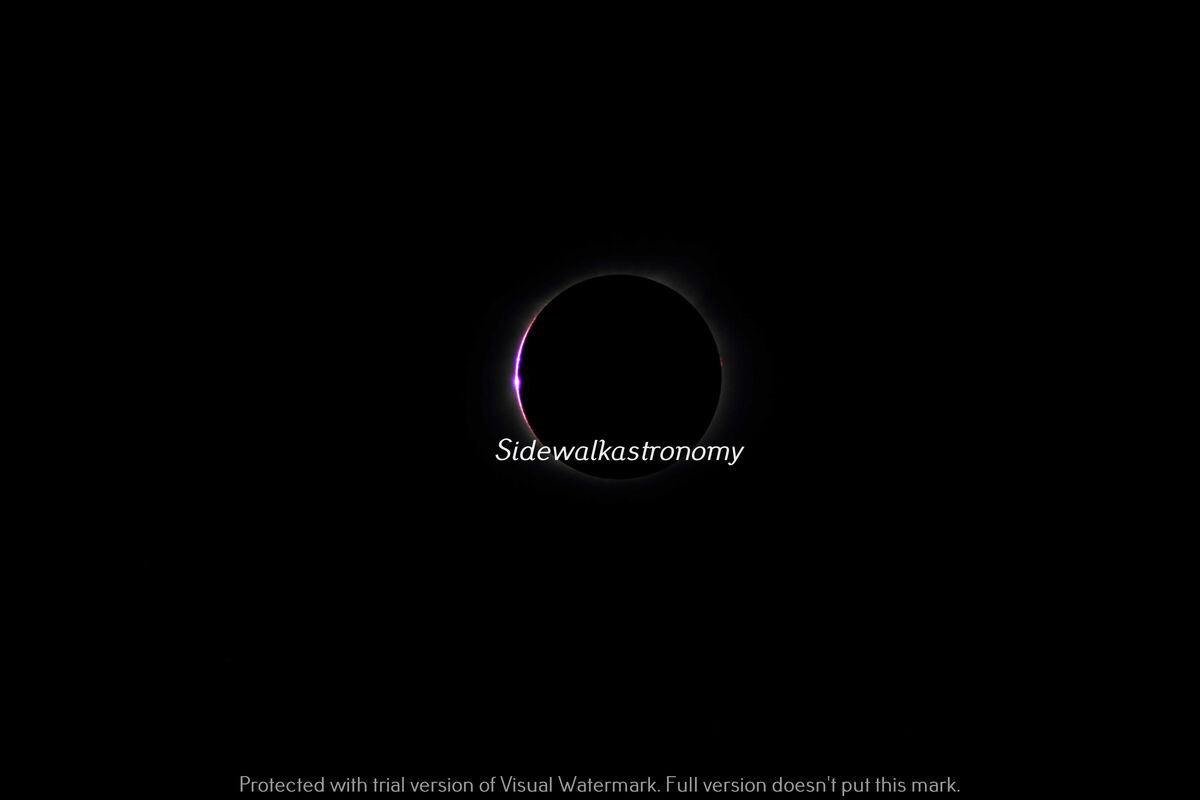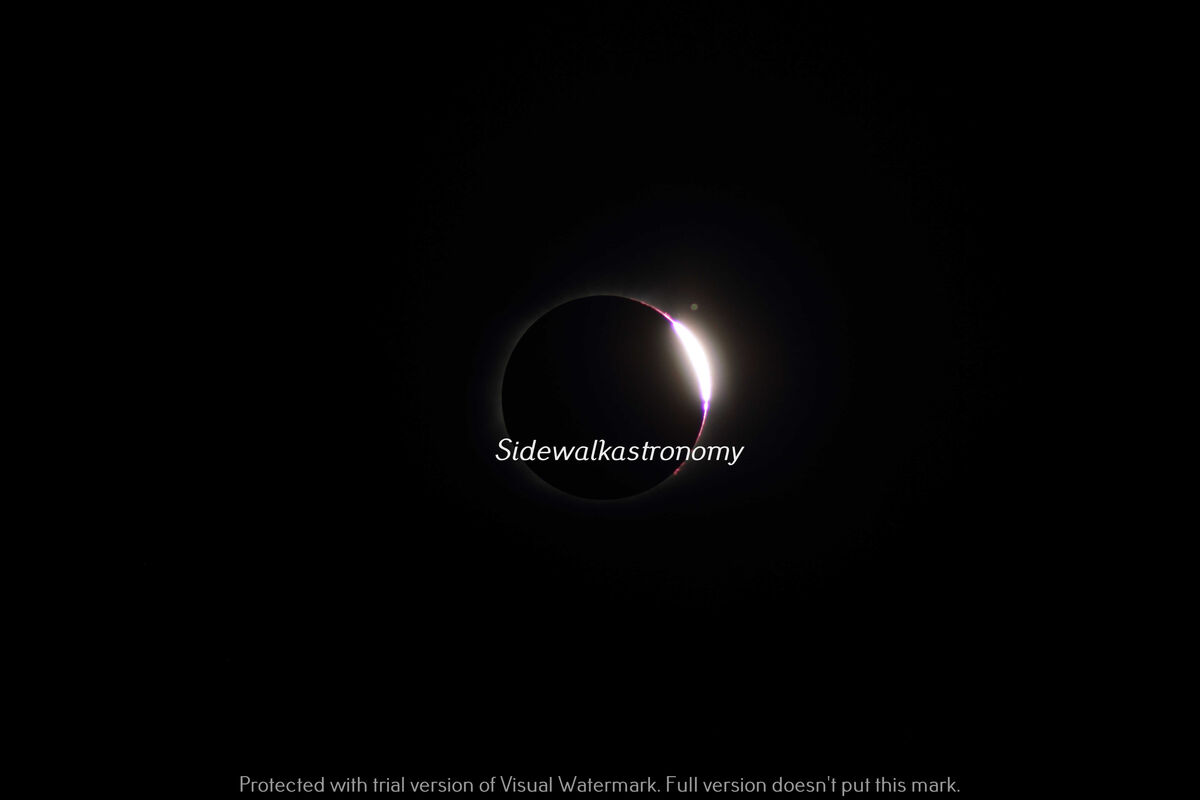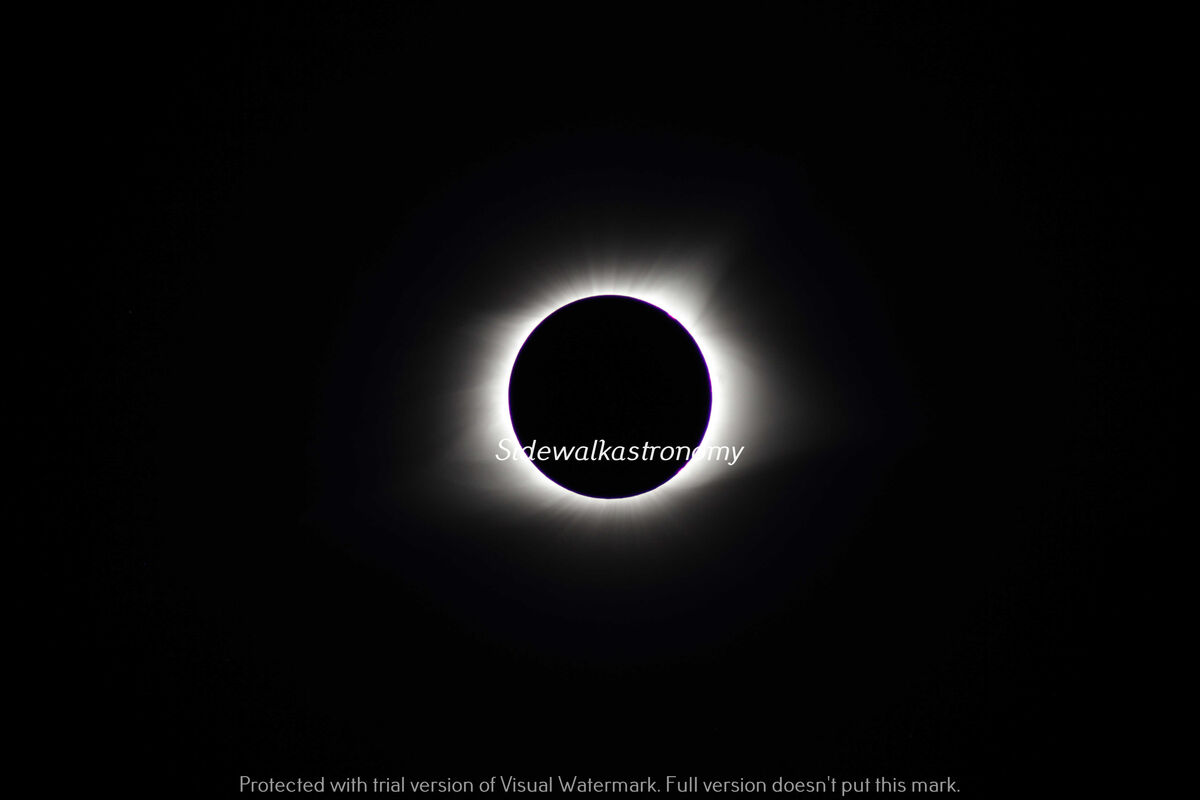Photographing Solar Eclipse
Dec 25, 2023 11:21:46 #
I am going to Texas to witness the Total Solar Eclipse on April 8 2024. I have a Z8 and 70-200 is my longest lens. Please give recommendations for
1) Shooting techniques
2) Solar filter to purchase. This event is the only time I will ever use the filter, but I want to protect my camera.
1) Shooting techniques
2) Solar filter to purchase. This event is the only time I will ever use the filter, but I want to protect my camera.
Dec 25, 2023 11:32:03 #
You don't need a filter during the total phase. 200mm is rather short for this purpose. I used a bridge camera during the 2017 eclipse set at full tele, ~1200 mm (35 equiv) and still cropped the image.
Dec 25, 2023 14:39:30 #
PHRubin wrote:
You don't need a filter during the total phase. 200mm is rather short for this purpose. I used a bridge camera during the 2017 eclipse set at full tele, ~1200 mm (35 equiv) and still cropped the image.
He is correct! You Do Not need a filter during the total phase. If you are trying to photograph the beginning phases then Yes you need a filter. The longer lens the better. I was using a 400mm lens and still cropped the image. Good Luck
Dec 25, 2023 14:42:45 #
If you are serious abut getting this right then some planning is necessary.
https://www.uglyhedgehog.com/t-478508-1.html
https://www.uglyhedgehog.com/t-478508-1.html
Dec 25, 2023 19:20:09 #
Marihet wrote:
I am going to Texas to witness the Total Solar Eclipse on April 8 2024. I have a Z8 and 70-200 is my longest lens. Please give recommendations for
1) Shooting techniques
2) Solar filter to purchase. This event is the only time I will ever use the filter, but I want to protect my camera.
1) Shooting techniques
2) Solar filter to purchase. This event is the only time I will ever use the filter, but I want to protect my camera.
First of all I refer you to my several replies on a post "Preparing for the Total Eclipse" posted Nov. 26 2023. It can be found under Watched Topics.
I used an 80-200 lens during the totality but I was using a DX camera so it was a 35mm equivalent 300mm lens. That said, cropping was still necessary. If you can't get, rent or borrow a zoom with max of 300-400mm just go with the 70-200. Even with the extra cropping I don't think you will be disappointed. I recommend zoom because when the filter is on during pre and post totality it is very difficult to find the sun unless you can zoom out, locate the sun, center it and then zoom in. Get a filter of 16 to 20 stop value. I will be in Mason Texas, northwest of Austin. Lets hope for clear skies.
Dec 25, 2023 20:35:17 #
druthven wrote:
First of all I refer you to my several replies on ... (show quote)
Cool! I live in NE Ohio where the pathway is almost overhead BUT the chances of a clear sky is minimal that time of year Unfortunately.
Dec 25, 2023 22:06:10 #
I am going to Dallas. My camera is a full
frame. My lens choices are 500 PF, 70-200, or 70-300 (not as good a lens as the other two). I bought solar film filters from Thousand Oaks Optical that slip on and off the lens. I have saved all these threads.
frame. My lens choices are 500 PF, 70-200, or 70-300 (not as good a lens as the other two). I bought solar film filters from Thousand Oaks Optical that slip on and off the lens. I have saved all these threads.
Dec 26, 2023 05:45:58 #
Judy795 wrote:
I am going to Dallas. My camera is a full
frame. My lens choices are 500 PF, 70-200, or 70-300 (not as good a lens as the other two). I bought solar film filters from Thousand Oaks Optical that slip on and off the lens. I have saved all these threads.
frame. My lens choices are 500 PF, 70-200, or 70-300 (not as good a lens as the other two). I bought solar film filters from Thousand Oaks Optical that slip on and off the lens. I have saved all these threads.
See this link for focal length discussion:
https://www.mreclipse.com/SEphoto/SEphoto.html#:~:text=Longer%20focal%20lengths%20permit%20photography,1000mm%20with%20crop%20sensor%20DSLR).
For a total solar eclipse, you want to capture the corona, which is three times the size of the sun. Maximum focal length on a FF camera should be 800-1000mm.
The sun is moving, so unless you have a tracker you will need to adjust position or let it move through the frame. As a result, I think 500-600mm is a good choice for FF. Shorter focal lengths are recommended for crop sensors to get within that range in equivalent focal length.
Finding the sun can be an issue, and you don't want to be fiddling about when the eclipse is going on. I use a Televue Sol-Searcher Solar Finder.
https://www.amazon.com/Televue-SSF-1006-Sol-Searcher-Solar-Finder/dp/B000B785SG/
With a solar filter, I use a zoom lens to acquire the sun, zoom in to fine-tune the pointing, and then lock the solar finder in position. I can then switch to the telephoto prime and use the solar finder to acquire the sun.
I highly recommend using a geared head to adjust pointing. This is the most precise adjustment, because the head remains under load while adjusting position, so it isn't subject to droop. I also prefer a geared head because I use a tracker, and it's easier to adjust the track with the fine adjustments available with a geared head.
A gimbal head also works very well because the camera is balanced. A two axis video fluid head is my next choice, but balancing the camera is trickier and I have used nodal rails and counterweights to achieve balance. The worst choice is a ball head with an unbalanced camera; way too much time fiddling and compensating for droop during a critically short time.
I have used foil filters on my larger lenses; these work well and can be put on/taken off quickly. But with the mounts they are large and very fragile. On smaller lenses I use a glass threaded filter, but use the Xume magnetic filter adapters for quick on/off.
I also use an external intervalometer for Timelapse shots during the eclipse. I shoot brackets to get proper exposure, especially during totality where I'm trying to get the corona but also avoid blowing out the flares. I like the Pluto intervalometer because it can be set up and changed quickly with the phone app, and I don't have to try to see the small dim screen of a standard intervalometer in the dark of totality.
Dec 26, 2023 09:41:23 #
Sidwalkastronomy
Loc: New Jersey Shore
Judy795 wrote:
I am going to Dallas. My camera is a full
frame. My lens choices are 500 PF, 70-200, or 70-300 (not as good a lens as the other two). I bought solar film filters from Thousand Oaks Optical that slip on and off the lens. I have saved all these threads.
frame. My lens choices are 500 PF, 70-200, or 70-300 (not as good a lens as the other two). I bought solar film filters from Thousand Oaks Optical that slip on and off the lens. I have saved all these threads.
I have several thousand oak solar filters for the sun with a few telescopes.. Excellent results looking through them. I took 1500+ photos during the 2017 eclipse with a computer controlled tracking scope. You might spend more time finding the sun and miss the enjoyment. I took various exposures and the Corona came out different sizes.
Dec 26, 2023 11:12:42 #
jcboy3 wrote:
See this link for focal length discussion: br br ... (show quote)
Excellent info. If you want the Corona, you also really need to shot at different exposures and combine HDR.
Get a filter and shoot some images, then you'll see the image size with what you have, 200 too short as stated.
Dec 26, 2023 11:17:55 #
DRM
Loc: NC
Marihet wrote:
I am going to Texas to witness the Total Solar Eclipse on April 8 2024. I have a Z8 and 70-200 is my longest lens. Please give recommendations for
1) Shooting techniques
2) Solar filter to purchase. This event is the only time I will ever use the filter, but I want to protect my camera.
1) Shooting techniques
2) Solar filter to purchase. This event is the only time I will ever use the filter, but I want to protect my camera.
As others have suggested, 200mm is very short for shooting an eclipse. In 2017, I used a 500mm f/4 plus 1.4x teleconverter on a full frame body--700mm effective focal length. There was still tons of room for cropping. I would suggest renting a long lens for the eclipse, in a focal length of at least 400mm (preferably longer and/or coupled with a teleconverter).
Regarding solar filters, I used an Orion glass solar filter for telescopes that conveniently fits perfectly over the external hood of the 500mm f/4 lens. That worked beautifully, and at a relatively reasonable cost. You mention that you will only use a solar filter once . . . but if that's the case, keep in mind that this, then, is a "once in a lifetime" shoot for you. Worth a bit of extra investment for equipment protection as well as quality results, perhaps. Just don't forget to remove whatever filter you use as totality begins, and to replace it as totality ends!
One additional equipment item I found invaluable during the 2017 eclipse was an angle viewfinder. The angle of the sun during the roughly three-hour event was high enough that crouching low enough to follow and photograph the process would have been awkward and uncomfortable for someone my age. The angle viewfinder eliminated that necessity completely, and coupled with the gimbal head I used, helped make the entire process easy and comfortable.
Finally, while the various tracking solutions mentioned by others have great value--especially during the frantic three or four minutes of totality (or less possibly, depending on location and the sun's path)--during the pre- and post-totality hours of the eclipse, there's plenty of time to find and center the sun in the frame for "progress" shots. During the majority of the 2017 event, I only shot a couple frames every 5 - 10 minutes. From those roughly four dozen images (plus nearly as many during the three minutes of totality), I was able to create an 11-image progression composite that clearly reflects the eclipse progress before, during, and after, an image I have sold hundreds of times in the six years since--even including once last week, despite the time elapsed since the 2017 event and the impending 2024 eclipse.
Dec 26, 2023 11:39:46 #
Sidwalkastronomy
Loc: New Jersey Shore
DRM wrote:
As others have suggested, 200mm is very short for ... (show quote)
Here are some of my results. One is bailey's beads, last bit of sun going through a crater, second one is diamond ring.
Dec 26, 2023 11:56:05 #
Spend the money on a good solar filter. It will be cheaper than replacing a lense or camera. I paid about $80 for mine a few years ago. I've had a couple of chances to use it since
Dec 26, 2023 11:59:45 #
Dec 26, 2023 13:01:41 #
Sidwalkastronomy
Loc: New Jersey Shore
Exposure is the unknown so every 5 min took exposure from 1/2000 to a second. Totality came and non stop at different exposure. All on an 80 mm telescope on a Celestine tracking mount
If you want to reply, then register here. Registration is free and your account is created instantly, so you can post right away.




